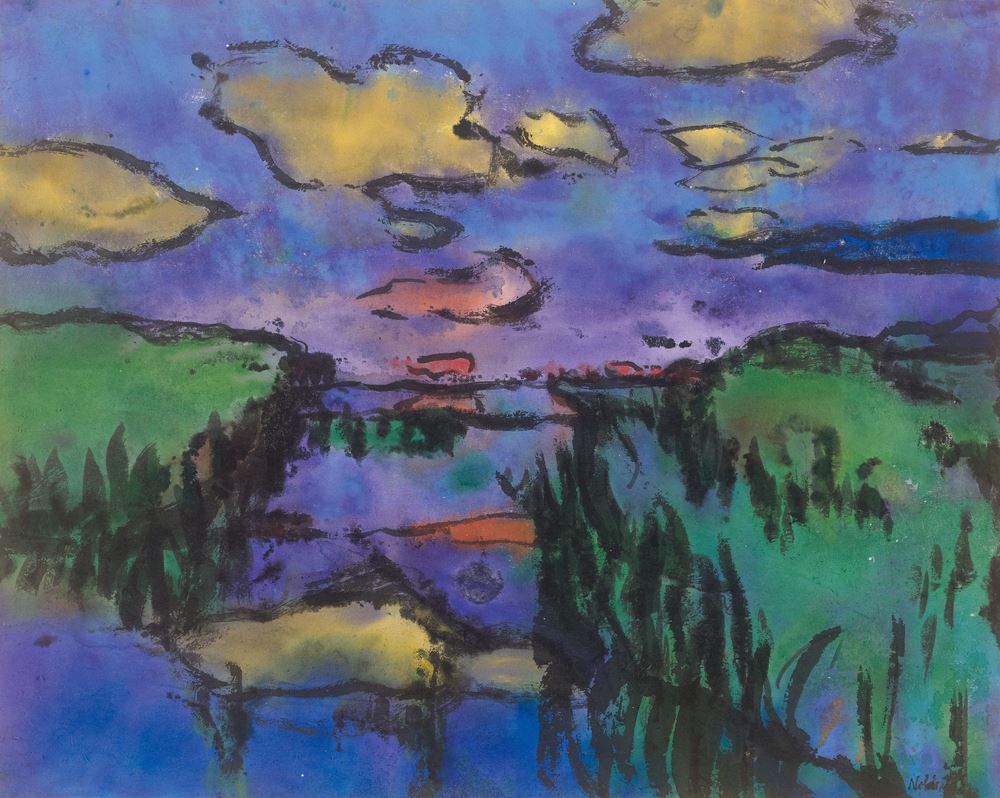
Lot 3229 - A183 Art Impressionniste & Moderne - vendredi, 08. décembre 2017, 16h00
EMIL NOLDE
The work is registred in his archive under the number "Nolde A-52/2017".
Provenance: Private collection, Switzerland.
Emil Nolde's landscape watercolours are among the outstanding works of his oeuvre. The works are characterised by their vibrant tones and strong contrasts, flowing colours and expressionistic intensity. The watercolour technique accompanied Nolde throughout his entire artistic practice, a primary reflection of the artist's diversity. The watercolour offered here also presents such a work typical of Nolde. It was created around the year 1920. The work shows the amphibious landscape of the Wiedau lowlands at Ruttebüll Lake, a locality near Seebüll and also near his birthplace. In 1909 Nolde stayed for the first time in the small village near the Danish border, where he would later settle for 10 years starting in 1916. This location would have a formative influence on his entire later work: "My style of the last years to draw and paint copying nature and creating form – as completely as possible with the first stroke or first colour – was no longer enough for me. Drawing, I had wiped and scraped the paper until the ground was perforated in order to capture something else, and more than before, something more profound. The path of Impressionism suggested to me only a means, not a goal that was satisfactory." (cited in: "Jahre der Kämpfe". 1902-1914, p. 120). The path to expressive painting was thus consummated in Ruttebüll. Nolde was no longer satisfied painting nature as it is. He was instead interested in reinterpreting nature, developing it into a work of art through the "addition of one's own soul and spirit" (cited in: ibid, p. 20). The free use of colour became increasingly present and eventually a central character in his works. Our work presents a splendid example of Nolde's expressionism and use of colour, as seen in the rendering of the sky and water in wonderful, night-time shades of blue and violet, in the yellow and red clouds reflecting in the lake, and in the lush green of the meadow. On the one hand, the colours stand apart from each other in individual fields, and yet they flow into one another at the same time.
In addition to this new vision of art, Nolde started to employ other materials. Thus, from the 1910s onwards, he explored the use of Japan paper and chose this as the support for his watercolours. This served to develop the penetration of the pigments, the dissolution and the fusion of contours, and is an essential characteristic of Nolde's watercolours. The landscape around Utenwarf and the Ruttebüll lowlands provided motifs for numerous watercolours which the artist made during his stay there. Our work is an impressive example showing the strength and intensity Nolde skilfully brought to his watercolours.
CHF 80 000 / 120 000 | (€ 82 470 / 123 710)
Vendu pour CHF 108 500 (frais inclus)
Aucune responsabilité n'est prise quant à l´exactitude de ces informations.

